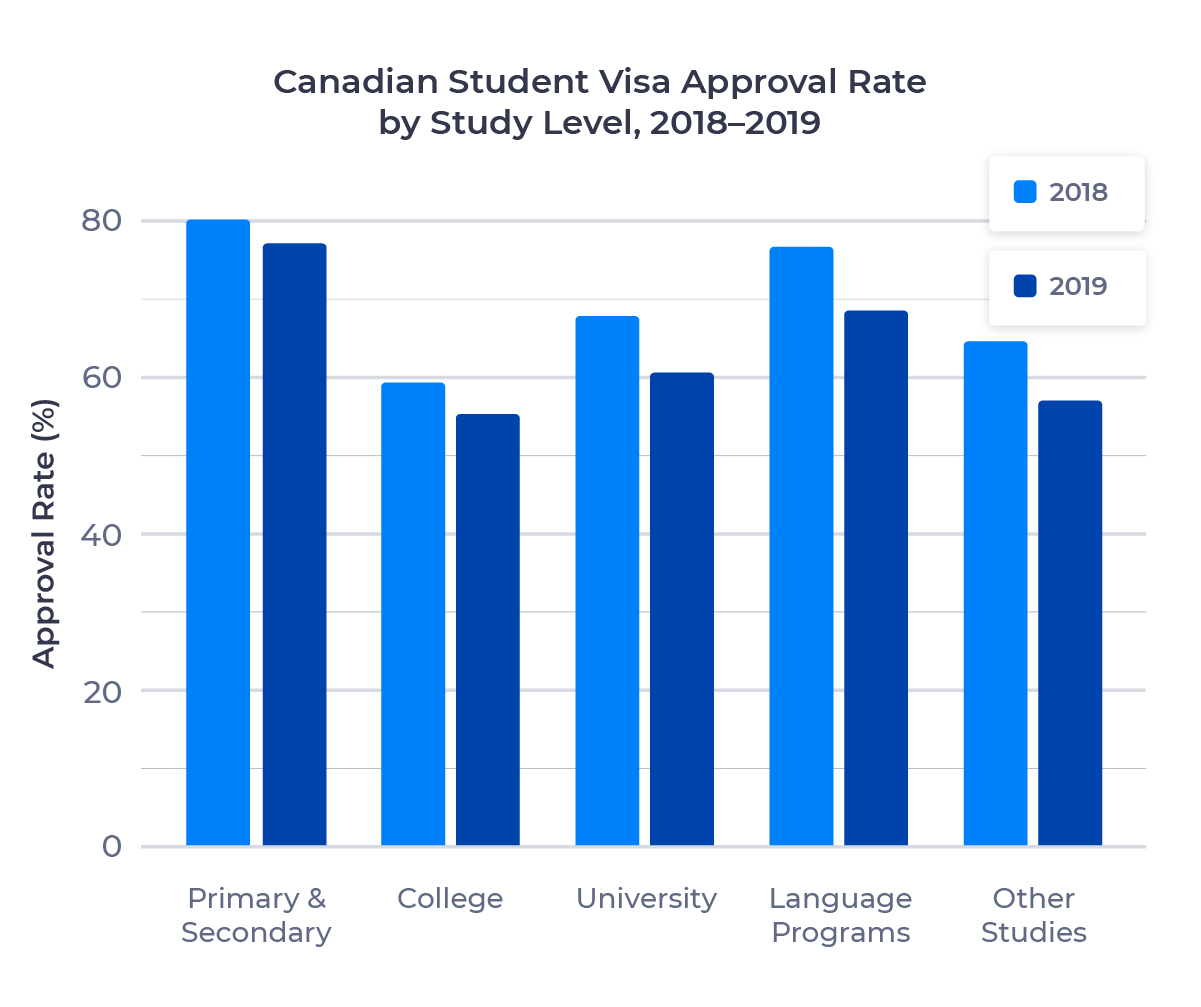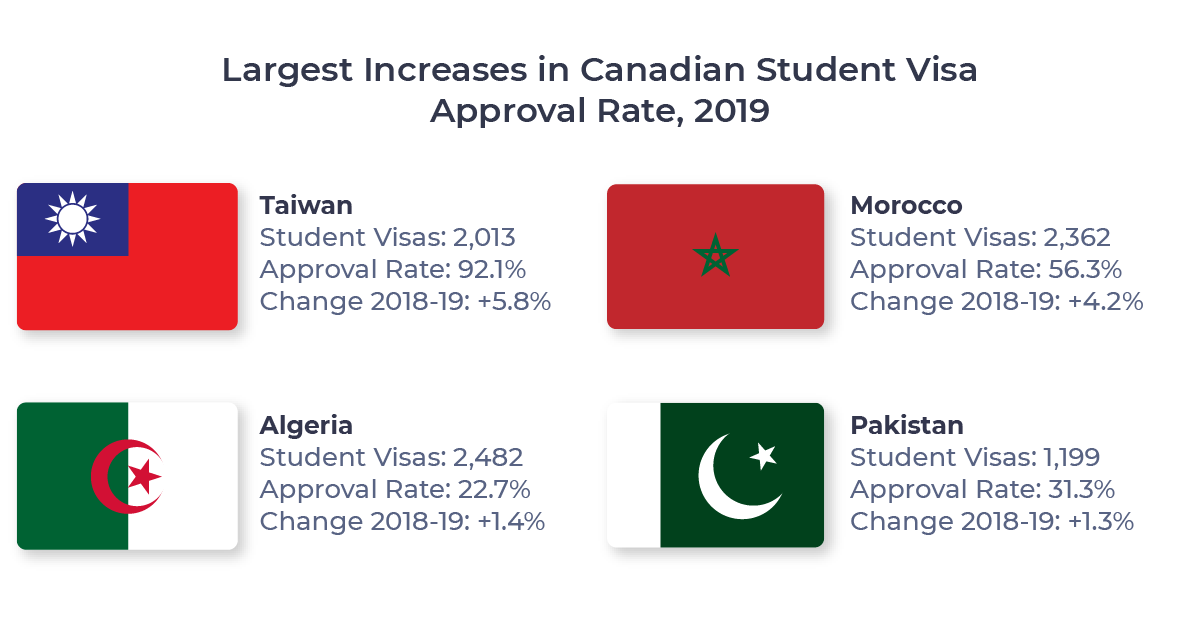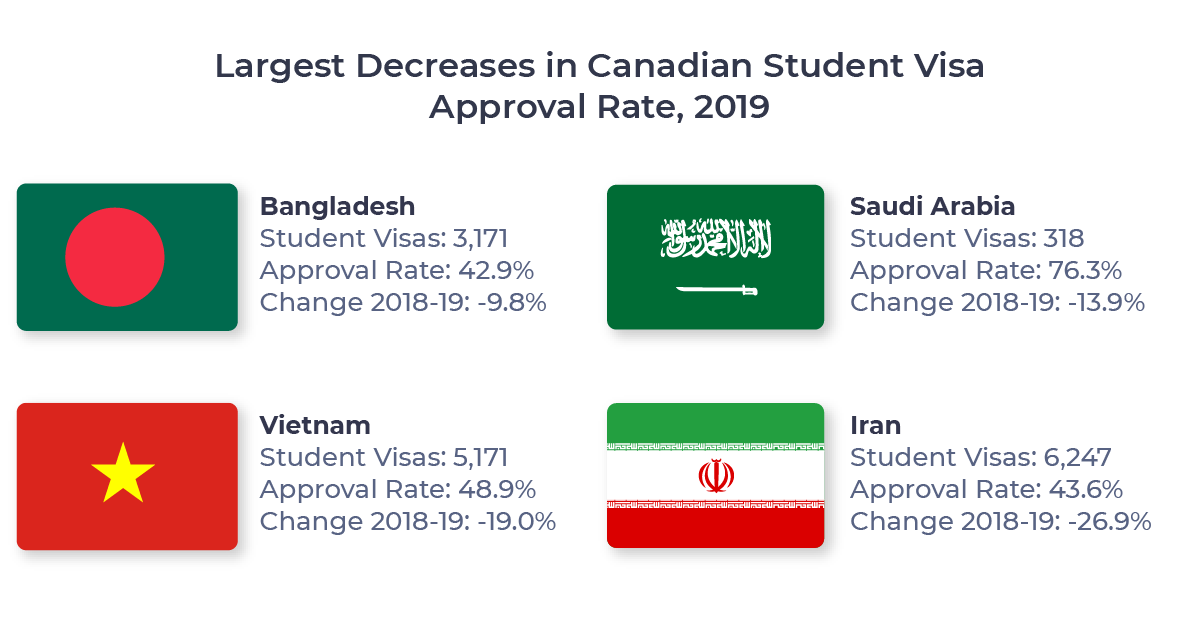In this edition of ApplyInsights, I’m examining Canadian student visa1 approval rates and how they changed between 2018 and 2019. Getting approved for a student visa is one of the first steps to studying abroad, so knowing how student visa approval rates are trending can tell us a lot about where the international student market is headed.
In this article, I’ll be restricting my analysis to countries that had over 1,000 student visa approvals in 2018. Check out our follow-up article for changes in visa approval rates for some of the less mature source markets.
Here’s what this article will cover:
- Changes in key Canadian student visa statistics between 2018 and 2019
- The four source countries that saw the largest year-over-year increase in approval rate, and what I think may have driven those trends
- The four source countries that saw the largest year-over-year drop in approval rate, and my thoughts on factors affecting those changes
Overview: Canadian Student Visa Approval Rates
The table below highlights changes in key Canadian student visa statistics between 2018 and 2019:
| 2018 | 2019 | Change | |
|---|---|---|---|
| Applications | 342,702 | 426,594 | +24.5% |
| Approvals | 227,798 | 256,546 | +12.6% |
| Approval Rate | 66.5% | 60.1% | -6.3% |
The Canadian student visa approval rate dropped from 66.5% to 60.1% between 2018 and 2019. At the same time, the number of student visa applications increased by almost 25%. The net result was that student visa approvals grew by almost 30,000 year-over-year, a 12.6% increase.
A key factor to keep in mind when discussing student visa approval rates is that they can vary significantly by study level. The chart below breaks this down:

Taken together, primary and secondary schools had the top approval rate in both years, settling in at 77.2% in 2019. In contrast, the college approval rate fell to 55.1%, the lowest rate among sectors.
It’s important to note that the decrease in approval rates occurred across all study levels, though not equally. Primary and secondary school approvals declined the least (3.3%), with college next (4.5%) despite its lower overall rate.
The remaining three study levels—university, language programs, and other studies, which includes Quebec-based training and vocational programs and any spouses or children of international students who hold a study permit themselves—fell the furthest, declining between 7 and 9% year-over-year.
Canadian Student Visa Approval Rates by Country
Let’s turn to country-specific approval rates. 25 countries surpassed 1,000 student visa approvals in 2018. These countries are the biggest players in Canadian education.
Anchored by India and China, which supply more than half of Canada’s international student population, this group accounted for 88.5% of all student visa approvals in 2018. With such large student populations, we would expect approval rates for these countries to be fairly stable, and that holds true, with 13 of the top 25 countries seeing a less than 2% change in student visa approval rate.
Nevertheless, there were some significant outliers, particularly on the negative side. Let’s take a look at which countries those were and the factors that might have contributed to the change.
Largest Increases in Approval Rate
We’ll start with the positive side. Canadian student visa approval rates increased for just 7 of the top 25 source countries in 2019. The figure below shows the top four:

Let’s take a look at each of these countries more closely.
Taiwan
Taiwan’s visa approval rate, already high in 2018, went up 5.8% year-over-year to 92.1%, the largest increase among the top 25. Rates were up across all study levels, led by a 10.4% increase in the approval rate for college students. Taiwan was by far the largest source country, and one of just three source countries overall, for which approvals increased as total applications decreased.
Morocco
Morocco’s approval rate increased 4.2%, accompanying a 44.9% boom in applications. The college sector drove the increase for Morocco as well, with almost 500 additional applications and a 7.5% higher approval rate.
The expansion of the Student Direct Stream (SDS) to Morocco in September 2019 likely drove this spike. SDS is a more efficient study permit processing system available only to citizens of specific source countries. By making the study permit application process less onerous, SDS typically attracts stronger applicants.
Algeria
Algeria had a 21.2% visa approval rate in 2018, the lowest among the top 25 source countries. But the North African nation did trend upward in 2019, with a 1.4% increase in approval rate. This uptick was driven almost entirely by growth in the bachelor’s degree market, which accounted for 4,606 net new applications and saw a 2.1% increase in approval rate. This counteracted approval rate decreases across other study levels, as well as university graduate programs.
Pakistan
Pakistan saw a modest 1.3% increase in approval rate between 2018 and 2019. Like Morocco, it was added to the SDS system last year, which likely explains the increase.
Largest Decreases in Approval Rate
On the negative side, four countries saw approval rates decline beyond the 6.3% average for all countries:

Let’s take a look at each of these countries in a little more detail.
Bangladesh
Bangladesh’s approval rate decreased 9.8% in 2019, falling to 42.9%. Approval rates were down across all major sectors, though rates for a few smaller components of the Bangladeshi market, such as primary schooling, language training, and doctoral programs, actually increased year-over-year.
The larger decline may reflect the Canadian government’s concerns about fraud in the market, something we’ve been working hard to combat at ApplyBoard through solutions like ApplyProof, our secure platform for digital document verification.
Saudi Arabia
Saudi Arabia’s approval rate dropped 13.9% between 2018 and 2019, more than twice the average decline for all countries. This accompanied a 70% erosion in visa applications year-over-year. This collapse in applications stems from a diplomatic dispute between Canada and Saudi Arabia that began in August 2018 and led the Saudi government to freeze all commercial ties with Canada. This included cancelling generous government-sponsored scholarships for students studying there.
With the sudden removal of a strong financial incentive to study in Canada, we would expect applicant quality from Saudi Arabia to decline, leading in turn to the drop in approval rate.
Vietnam
Vietnam saw a massive 19.0% decline in approval rate, from 67.9% in 2018 to 48.9% in 2019. College approvals, in particular, tumbled 25.8%. We can tie this directly to the end of the Canada Express Study (CES) Program, an Immigration, Refugees and Citizenship Canada (IRCC) pilot initiative that ran from 2016 to 2018 and facilitated visa processing for Vietnamese students looking to study at participating colleges.
The Canadian government introduced SDS to China, India, Vietnam, and the Philippines in June 2018. Its aim was to replace the CES program in Vietnam, and similar initiatives in those other countries, with a single program designed to expedite visa applications for highly competitive applicants. While SDS is much more efficient than the standard Canadian study permit processing system, it is more demanding than CES, and I suspect the transition between programs is responsible for much of the decline in approval rates from Vietnam.
Iran
Iran saw the largest decline in Canadian visa approval rate for any country with more than 75 applicants—a whopping 26.9%. This decline applied across study levels, with university rates falling by 16.3%, college rates by 24.8%, and primary and secondary rates by 36.0%. Only doctoral studies resisted the decline.
This drop in approval rate coincided with a 70% year-over-year increase in student visa applications from Iran that reflected a shift in Iranian interest to studying in Canada rather than the United States following a souring of the Iran-US relationship.
2019 was a difficult year for Iran, with deteriorating economic conditions leading to widespread civil unrest. A challenging domestic political environment often leads students to pursue opportunities abroad, and I suspect these conditions motivated both a further increase in Iranian interest in Canada as a study destination and more careful scrutiny of visa applications from Iranians by the Canadian government.
Summary
I always love diving into student visa data. There’s so much to sift through and learn from, and I hope this article has helped you get a sense of how the Canadian international student market has trended over the past couple years across study levels and source countries.
Of course, the dominant story of 2020 remains the COVID-19 pandemic, and factors ranging from outside perceptions of Canada’s handling of the pandemic, to government policy changes to address international student needs, to timelines for the relaxation of travel restrictions will have a huge bearing on how these numbers shift going forward. But as applications for January 2021 continue to tick up, I’m increasingly optimistic that international education in Canada will emerge from the pandemic strong, and I suspect we’ll see a good number of these trends continue post-COVID-19.
Check back with ApplyInsights in a few weeks for a look at trends in student visa approval rates among some of the smaller, but still critical, source countries for the Canadian international student market.
Subscribe to ApplyInsights
Sign up for the latest insights on international education.

Co-Founder and Chief Marketing Officer (CMO)
Meti is driven by the belief that education is a right, not a privilege. He leads the International Recruitment, Partner Relations, and Marketing teams at ApplyBoard, working to make education accessible to people around the world. Meti has been instrumental in building partnerships with 1,200+ educational institutions across North America and the United Kingdom. Working with over 4,000 international recruitment partners, ApplyBoard has assisted over 100,000 students in their study abroad journey. Follow Meti on LinkedIn for more access to ApplyInsights and key industry trends.
FOOTNOTES:
1. The terms student visa and study permit are often used interchangeably when discussing Canadian international education and immigration. Students need a visitor visa to enter Canada, but one is often issued with an approved study permit.



